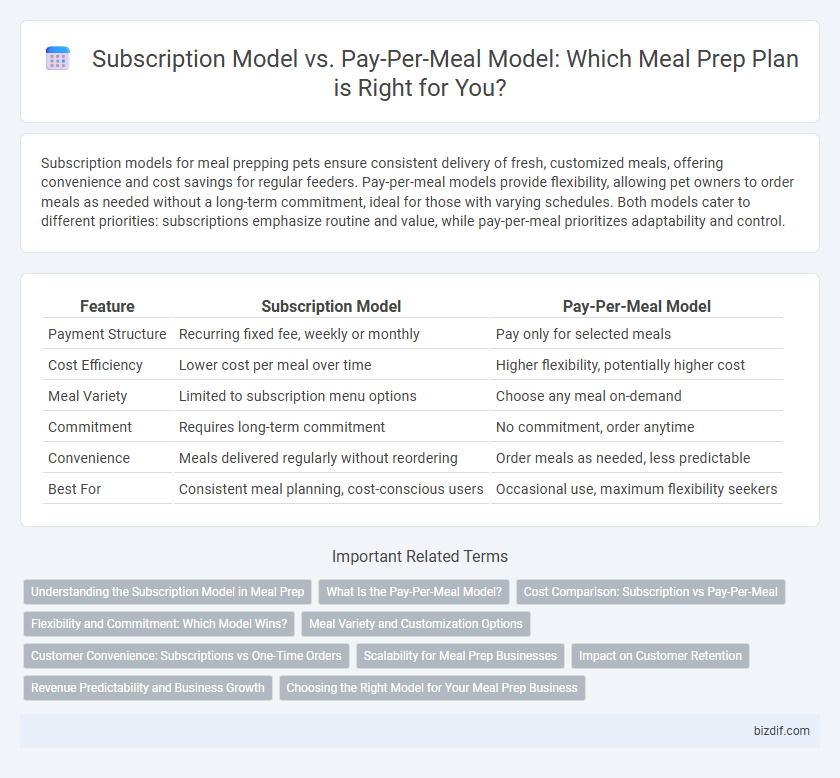Subscription models for meal prepping pets ensure consistent delivery of fresh, customized meals, offering convenience and cost savings for regular feeders. Pay-per-meal models provide flexibility, allowing pet owners to order meals as needed without a long-term commitment, ideal for those with varying schedules. Both models cater to different priorities: subscriptions emphasize routine and value, while pay-per-meal prioritizes adaptability and control.
Table of Comparison
| Feature | Subscription Model | Pay-Per-Meal Model |
|---|---|---|
| Payment Structure | Recurring fixed fee, weekly or monthly | Pay only for selected meals |
| Cost Efficiency | Lower cost per meal over time | Higher flexibility, potentially higher cost |
| Meal Variety | Limited to subscription menu options | Choose any meal on-demand |
| Commitment | Requires long-term commitment | No commitment, order anytime |
| Convenience | Meals delivered regularly without reordering | Order meals as needed, less predictable |
| Best For | Consistent meal planning, cost-conscious users | Occasional use, maximum flexibility seekers |
Understanding the Subscription Model in Meal Prep
The subscription model in meal prepping offers consumers consistent delivery of pre-portioned meals, enhancing convenience and time savings. Subscribers benefit from flexible plans tailored to dietary preferences and portion sizes, often receiving cost savings compared to pay-per-meal options. Meal prep companies leverage this model to forecast demand, reduce food waste, and build customer loyalty through personalized service and predictable revenue streams.
What Is the Pay-Per-Meal Model?
The pay-per-meal model allows customers to purchase individual meals without committing to a recurring subscription, offering greater flexibility and control over meal choices and frequency. This model appeals to occasional users or those who prefer to try different meals without being locked into regular deliveries. It also helps providers attract a broader audience by catering to varying meal prep preferences and budgets.
Cost Comparison: Subscription vs Pay-Per-Meal
Subscription models for meal prepping often provide significant cost savings, averaging 20-30% less per meal compared to pay-per-meal options due to bulk purchasing and streamlined delivery logistics. Pay-per-meal models offer flexibility without long-term commitment but tend to have higher per-meal prices, sometimes up to 40% more expensive. Evaluating factors like frequency, meal variety, and budget is crucial for optimizing cost efficiency between subscription and pay-per-meal services.
Flexibility and Commitment: Which Model Wins?
The pay-per-meal model offers greater flexibility by allowing customers to order meals as needed without long-term commitments, making it ideal for those with unpredictable schedules. Subscription models, while often providing discounts and predictable meal planning, require a commitment that may not suit everyone's fluctuating lifestyle. Consumers prioritizing adaptability and minimal obligation tend to favor the pay-per-meal approach over subscription plans.
Meal Variety and Customization Options
Subscription models for meal prepping often provide a wider variety of meals and better customization options, allowing subscribers to select preferences, dietary restrictions, and rotate menus regularly. Pay-per-meal models typically offer less flexibility, with limited meal choices and fewer opportunities to tailor ingredients to individual tastes or nutritional needs. Consumers seeking diverse, personalized meal experiences tend to favor subscription services for their enhanced customization and meal variety.
Customer Convenience: Subscriptions vs One-Time Orders
Subscription models for meal prepping offer customers consistent delivery schedules and simplified budgeting, enhancing overall convenience by eliminating the need to reorder frequently. Pay-per-meal models provide greater flexibility, allowing customers to choose meals on an as-needed basis without long-term commitment. Balancing convenience and adaptability, subscription plans suit those valuing routine, while one-time orders cater to varied schedules and preferences.
Scalability for Meal Prep Businesses
Subscription models offer meal prep businesses predictable revenue streams and improved customer retention, enabling easier scalability through consistent demand forecasts and streamlined inventory management. In contrast, pay-per-meal models result in variable order volumes that can complicate supply chain planning and increase operational inefficiencies, limiting growth potential. Meal prep companies aiming for scalability benefit from subscription frameworks that foster customer loyalty and stable cash flows, essential for expanding production capacity and distribution networks.
Impact on Customer Retention
The subscription model in meal prepping enhances customer retention by providing consistent meal delivery and fostering a sense of commitment, which reduces churn rates. Pay-per-meal models offer flexibility but often lack the ongoing engagement that drives long-term loyalty, leading to more sporadic customer interactions. Data shows subscription-based services retain up to 30% more customers compared to pay-per-meal options due to predictable value and convenience.
Revenue Predictability and Business Growth
Subscription models in meal prepping offer predictable monthly revenue by securing committed customers, enabling efficient inventory management and scalable business growth. Pay-per-meal models generate variable income, increasing cash flow volatility and complicating long-term planning but attracting a broader customer base with flexible purchasing options. Businesses leveraging subscription models typically experience higher customer retention rates and smoother revenue streams, fostering sustainable expansion and operational stability.
Choosing the Right Model for Your Meal Prep Business
Selecting the ideal pricing strategy for a meal prep business hinges on customer demand patterns and cash flow stability. Subscription models offer consistent revenue streams and foster long-term customer loyalty through convenience and cost savings. Pay-per-meal models provide flexibility for occasional buyers and minimize commitment barriers, appealing to customers seeking variety and control over their orders.
Subscription Model vs Pay-Per-Meal Model Infographic

 bizdif.com
bizdif.com